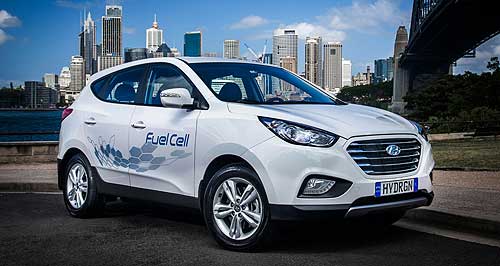Future models - Hyundai - ix35 - Fuel CellHyundai working on ground-up FCEVIt’s a gas: Hyundai’s first FCEV is based on the ix35 small SUV, but the next one will be based on its own ground-up design. Unique platform being developed for Hyundai’s 2018 hydrogen car29 Sep 2016 By RON HAMMERTON in PARIS HYUNDAI’S next-generation hydrogen fuel-cell electric vehicle (FCEV) will be built on a unique platform when it arrives as the South Korean company’s environmental flagship in 2018. Already confirmed for Australia where the Australian Capital Territory (ACT) government has done a deal for a fleet of 20 once it goes on sale, the unnamed vehicle will have a target driving range of 800 kilometres on a tank of hydrogen – making it theoretically capable of driving from Sydney to Melbourne without stopping. Hyundai Motor Company Australia (HMCA) has been collaborating with rival Toyota Australia on ways to foster the necessary refuelling infrastructure for such vehicles. They have been in joint talks with government representatives in recent weeks about how to move forward with the hydrogen vehicle introduction that both companies see as the way of the future. Toyota is rolling out its Mirai FCEV globally, while Hyundai already has such a vehicle available in Korea and some other markets. The current Hyundai FCEV is based on the ix35, but Hyundai insiders have told GoAuto that the next version will have its own unique architecture to better accommodate the hydrogen tank and fuel cells that convert the gas to electricity, with only water vapour being emitted from the exhaust pipe. Hyundai’s other new green vehicle flag-waver, the electrified Ioniq small car that has been earmarked for sale in Australia from the second half of 2017, also has its own platform. Globally, the Ioniq will be offered in three choices – Prius-style hybrid, plug-in hybrid and full electric. Australia is yet to announce which versions it will take, but appears to be leaning towards the plug-in hybrid. In Paris, a fleet of Hyundai FCEV taxis are already on the streets. Australian journalists are being ferried to and from the Paris motor show in the taxis, which, to all intents and purposes, operate the same as normal internal combustion engine vehicles only quieter. One of the taxi drivers, Dominique, told GoAuto she could drive a whole shift on one tank of hydrogen, covering up to 500km through stop-start Paris traffic. She said she only needed to refuel at the end of the shift so the next driver could start without delay. So far, Paris has just one hydrogen refuelling station, in downtown Paris near the Seine River, where it makes a statement to the public about green motoring. Paris officials are keen to reduce the numbers of diesel vehicles on the streets of the French capital to reduce pollution and encourage environmentally sound cars. For taxis, electric vehicles with their limited range and long charging times make no sense, but the range and seven-minute refuelling time of FCEVs is a good fit. While critics of FCEVs point out that hydrogen to fuel requires energy in the manufacturing process, the ACT government is planning to use wind energy to generate the gas plant. In its announcement in August, the ACT said its Hornsdale Wind Farm stage 3 would supply renewable energy to a Siemens hydrogen refueller capable of powering 1000 FCEVs. So far, HMCA has only one FCEV in the country – a left-hand-drive ix35 for trial purposes – but has committed to introducing the next version, probably in late 2018. HMCA public relations manager Bill Thomas told GoAuto that FCEV sales figures would be low, perhaps up to 60 a year, but that the vehicle would make a statement about Hyundai.  Read more29th of September 2016  Hyundai’s new-model blitzEleven new models set to reshape Hyundai in Australia in 18 months30th of August 2016  ACT government purchases 20 Hyundai FCEVsTwenty Hyundai Fuel Cell Electric Vehicles bought as part of green initiative11th of July 2016  Trio of Toyota Mirais land in AusToyota announces three Mirais and refuelling station for Australian evaluation8th of April 2016  Hyundai pioneers fuel-cell car-sharing schemeZero-emissions hydrogen-powered small SUV will be made available in Munich, Germany25th of January 2016  Kia pushing for hydrogen power in AustraliaHydrogen fuel-cell the preferred alternative technology for Kia Motors Australia6th of October 2015  Hydrogen won’t be a tough sell: ToyotaToyota’s experience promoting hybrid tech will help with hydrogen rolloutAll future models Alfa Romeo Alfa Romeo Abarth Abarth Audi Audi Aston Martin Aston Martin BMW BMW Bentley Bentley Chrysler Chrysler Chevrolet Chevrolet Dodge Dodge Citroen Citroen Ferrari Ferrari DS DS Ford Ford Fiat Fiat FPV FPV Foton Foton Haval Haval Great Wall Great Wall Honda Honda Holden Holden Hyundai Hyundai HSV HSV Isuzu Isuzu Infiniti Infiniti Jeep Jeep Jaguar Jaguar Lamborghini Lamborghini Kia Kia Lexus Lexus Land Rover Land Rover Mazda Mazda Maserati Maserati Mercedes-Benz Mercedes-Benz McLaren McLaren Mini Mini Nissan Nissan Mitsubishi Mitsubishi Peugeot Peugeot Opel Opel Proton Proton Porsche Porsche Renault Renault Ram Ram Saab Saab Rolls-Royce Rolls-Royce Smart Smart Skoda Skoda Subaru Subaru SsangYong SsangYong Tesla Tesla Suzuki Suzuki Toyota Toyota Volvo VolvoMotor industry news |
Click to shareHyundai modelsResearch Hyundai All future models Alfa Romeo Alfa Romeo Abarth Abarth Audi Audi Aston Martin Aston Martin BMW BMW Bentley Bentley Chrysler Chrysler Chevrolet Chevrolet Dodge Dodge Citroen Citroen Ferrari Ferrari DS DS Ford Ford Fiat Fiat FPV FPV Foton Foton Haval Haval Great Wall Great Wall Honda Honda Holden Holden Hyundai Hyundai HSV HSV Isuzu Isuzu Infiniti Infiniti Jeep Jeep Jaguar Jaguar Lamborghini Lamborghini Kia Kia Lexus Lexus Land Rover Land Rover Mazda Mazda Maserati Maserati Mercedes-Benz Mercedes-Benz McLaren McLaren Mini Mini Nissan Nissan Mitsubishi Mitsubishi Peugeot Peugeot Opel Opel Proton Proton Porsche Porsche Renault Renault Ram Ram Saab Saab Rolls-Royce Rolls-Royce Smart Smart Skoda Skoda Subaru Subaru SsangYong SsangYong Tesla Tesla Suzuki Suzuki Toyota Toyota Volvo VolvoMotor industry news |
















Facebook Twitter Instagram